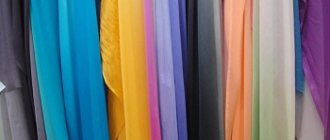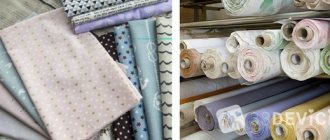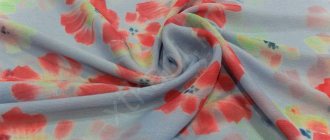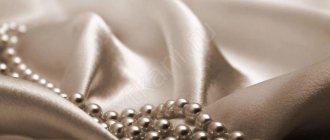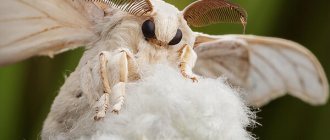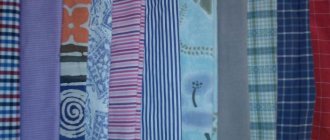Sewing seams on transparent fabrics
All transparent fabrics are very capricious in terms of finishing edge seams. In addition, the seams are visible on both sides, so special attention should be paid to their processing. Accordingly, the following seams are used when processing seams on transparent fabrics.
1. Simple seam
The parts are folded right sides together and the sections are ground down. The seam allowances are overlocked with an overlocker (2- or 3-thread), at the same time cutting off the seam allowances to a width of 0.5 cm or 0.75 cm. You can also overlock the seam allowances separately and iron them. The seams can also be finished on a sewing machine using a zigzag stitch. This stitch is laid at a distance of 0.75 cm from the seam, and then the excess allowances are cut off.
2. Covering seam
The cut pieces are folded right sides together and the edges are stitched down. Seam allowances are pressed to one side. The seam allowance lying below is cut to a width of 0.5 cm. The seam allowance lying on top is cut to a width of 1 cm, folded to a width of 0.5 cm and adjusted to the edge.
3. French or double seam
The cut pieces are folded wrong sides together and seam allowances are sewn to a width of 1 cm (= 0.5 cm from the marked seam line). The allowances are cut off at a distance of 0.5 cm from the completed seam and ironed. Then the parts are folded right sides together, so that the seam made runs exactly along the fold, and the stitching is laid at a distance of 0.5 cm from the fold exactly along the marked seam line, while the cut edges of the first seam are closed.
4. Topstitch stitch
The cut pieces are folded right sides together and the edges are stitched down. The seam allowances are cut to a width of 1 cm, ironed, folded to a width of 0.5 cm and adjusted to the edge.
Making darts on transparent fabrics Making tacks on a dart
At the top of the dart, do not tack or tie the ends of the threads, as they may be visible from the front side of the product. In this case, a clever tailoring trick will help: the top thread is removed from the sewing machine, and the bottom thread is threaded instead of the top thread in the opposite direction, starting from the needle, while the end of the thread located above the tension mechanism should be longer than the dart. The stitching starts from the top of the dart without a bartack. The seam will not diverge, since it is made with one thread.
Attention: stitching a dart from the top is not at all easy, so be sure to try this trick on a scrap piece first!
How to sew a chiffon dress with your own hands – Fashion – Home
If you want to sew a dress without a pattern, use the following model. To create it you will need a T-shirt. Take the one that fits you well. If it is made of jersey, it should not be too tight.
Fold the fabric in half lengthwise, place the T-shirt on top, and pin together. Trace the base onto the fabric or cut it out straight away, leaving a 7mm seam allowance.
The front and back of the bodice may be identical, but the latter has a smaller neckline.
Fold the bottom of the base up to the waistline, cut the fabric according to the markings, remembering to leave a seam allowance. The skirt for such a dress is cut from a rectangular piece. Also fold the fabric in half.
The skirt will be gathered, so its width should be 1.5 times the circumference of your hips. If you want a more magnificent one, you can take not 1.5, but 2 times more.
Cut out a rectangle of the desired length, the same length as the skirt.
Attach the bodice blank to this rectangle, matching the sides of these parts. Now lay even folds on its upper part, pinning each one with a pin. You can make assemblies using thread and needle.
Now you need to sew the cut out parts. Since the fabric is thin, use a special sewing machine needle that is designed for such fabrics. Take No. 80 or 70. Sew the shoulder seams of the bodice first, then the sides.
If the upper part is tight, sew a zipper on the left side into the side seam. Its lower part should go down to the skirt, which will also be fastened to it near the waist. But this needs to be done a little later.
Leave the left side of the bodice unstitched for now. Topstitch the skirt to secure pleats or gathers. Sew the side seams of the skirt, leaving an unsewn part at the top left as well.
Connect the bodice and skirt along the waist, sew in a zipper.
The fabric is thin and stretches well, so when processing the neckline and armholes you can do without hemming and bias binding. The main thing is to make the seam thin. To do this, turn the edge to the wrong side by 3-4 mm, then stitch the same amount. You can decorate the bottom in the same way or hem it on your hands. Once you have ironed the seams, the dress is ready to wear.
For another option on how to sew a summer dress, see the master class by designer Tasha Strogoy :
Caring for transparent fabric items
Organza and chiffon made from natural silk should be dry cleaned. Fabrics made from synthetic fibers can be washed with mild detergents in the washing machine on a gentle cycle or by hand. In this case, the products should not be rubbed or twisted, but only gently squeezed. Hang items to dry wet, without squeezing.
The cut details are sewn together with fine sewing threads or threads for machine embroidery and darning and a fine sewing machine needle No. 70 with a perfect point, preferably a needle for microfiber fabrics.
The seams are made by machine stitching with a small stitch (stitch length from 1.5 mm to 2 mm). Do not machine stitch over pins, as the thin fabric may tear. When basting, do not use thick basting threads, but thin sewing threads and a thin needle.
How to sew thin, slippery fabrics (chiffon and organza)
To sew dresses from capricious, but stunningly beautiful material, you need to follow the rules for processing the material.
How to cut airy materials.
Before cutting, the organza should be ironed well at medium heat. After ironing, the organza will become smooth and rigid. Chiffon should be cut with a rotary cutter or tailor's scissors, pinning the paper pattern with sharp tailor's pins, because any unevenness can seriously damage the fabric. Also, the paper pattern can be placed on special strips of glue.
Copying the seam line.
Bottom lines, seams and markings cannot be transferred using a copying cutter with a gear wheel and carbon paper, since marks from the teeth will be visible on the front side of the fabric and will be visible through. To copy the seams, you will need to lay a snare using an aqua marker or soap. Folds and lines should be marked with stitches using a thin thread and a needle.
Ironing.
For ironing organza and chiffon, only use a dry iron that does not use steam. When exposed to moisture, the fabric will wrinkle and become fibrous. You should also pay attention to the fact that the surface of the iron must be perfectly clean and without a single scratch, otherwise the delicate fabric will be damaged. The iron must be set to the “silk” mode or in the 1-2 position. For ironing, it is better to use papyrus paper, which reduces the risk of damage to delicate fabric.
Pad.
Translucent or low-temperature interlining is used as a lining, which is ironed dry at low temperature. You can use organza as a lining, which is placed to duplicate chiffon.
Sewing.
To sew parts and running seams, you must use a thin needle No. 60.70 and machine embroidery thread with a stitch length of 1.5-2 mm. The sewing needle must be perfectly sharp. Before sewing parts, you need to place transparent papyrus paper to prevent damage to the fabric by the sewing machine conveyor. Use a serger to finish the seams. To do this, at a distance of 5 mm from the cut, make a zigzag stitch with cutting off the allowance near it, or fold the fabric in half with the wrong side and stitch the seams along the middle of the line, and then fold the fabric with the right side and walk along the marked seam lines. This way you can hide the seams inside.
French piping is used to stitch the neckline of dresses, thereby hiding the raw edge. The piping is made from a strip of trim. The piping is sewn on after making the back fastener of the dress.
For the edging, strips are cut out with a width of 4.5 cm and a length slightly larger than the stitching line for processing the ends. Next, iron the bias strips, folding them in half with the inside out.
To hide the top of the darts, you need to thread the bottom thread into the needle from the bobbin and pass it like the top thread so that a knot does not form.
Care.
Clothing made from natural silk should be dry cleaned. And clothes made of synthetic silk can be washed by hand or in a washing machine, setting the gentle cycle. After washing, clothes should be carefully wrung out and hung to dry while wet. Chiffon clothes can be damaged by sweat. To solve this problem, you can sew armpits from knitwear or cambric.
Fabrics 3000 offers to buy chiffon in the online store at an attractive price. In clothes made of chiffon, you will truly feel all the lightness and freedom of this amazing fabric, which is so pleasant to the body.
Fabrics with elastic threads
These fabrics both stretch perfectly and hold their shape well due to the inclusion of elastic threads (elastane) in their composition, along with natural and synthetic fibers. These fabrics can stretch either transversely or longitudinally, or in both directions simultaneously. If the fabric stretches only in one direction, then the parts must be cut so that they stretch across.
Depending on the quality, elastic fabrics can shrink up to 5-10% when washed and ironed; we always take this possibility into account when calculating fabric consumption. Before cutting, be sure to iron the fabric with an iron with a humidifier or through a damp iron. Or wash the fabric if the care instructions allow it.
To sew cut parts from elastic fabrics, use a special needle. To ensure that the seams of the product remain elastic, the sections of the parts are stitched with a narrow zigzag stitch (stitch width is 0.5-1 mm, stitch length - 3-4 mm) or a special elastic stitch (see the instructions for your sewing machine). The hem of the bottom is adjusted with a double needle of a sewing machine, which gives 2 parallel straight lines on the front side of the product, and a zigzag stitch on the wrong side. Also monitor the thread tension in the sewing machine - it should not be too tight.
Mixed fabrics made from cotton, linen, viscose, synthetic fibers and elastane can be washed, but very carefully and using mild detergents. The temperature of the water depends on what fibers the elastane is mixed with. Elastic cotton fabrics are washed at a water temperature of 60°C, and in other cases the water temperature should not exceed 30-40°C.
Iron elastic fabrics with a low or moderately heated iron, having first tried it on an unnecessary flap.
Sewing
- Choose the thinnest needles with a very sharp point, as well as neat threads for machine embroidery and darning. The seams should have a small stitch gap (no more than two millimeters);
- be sure to stitch along the pins, otherwise you risk creating holes in the fabric;
- when making chiffon parts on a machine, be sure to place silk paper under them to prevent damage and snags;
- carefully and carefully overcast the seams, take your time. To make the process easier, you can use an overlocker, or use closed/double seams. In this case, the allowances must fall into the seam or fold (depending on the selected type of sewing);
- are you in a hurry? Do not iron the seam allowances, but simply stitch them in a zigzag manner, and then cut them off. Use this life hack only when you get perfectly even and beautiful stitches;
- You should not make knots at the ends of the thread when sewing darts - this will negatively affect the final result. Perform the final stitching with one thread, starting from the top without securing stitches. This is a rather labor-intensive process that requires a certain skill, so it is better to first practice on an unnecessary piece of fabric;
- last of all, it is worth processing the lower sections, paying close attention to this. The narrow hem at the bottom looks great from the outside. It can be done either manually or using a sewing machine.
